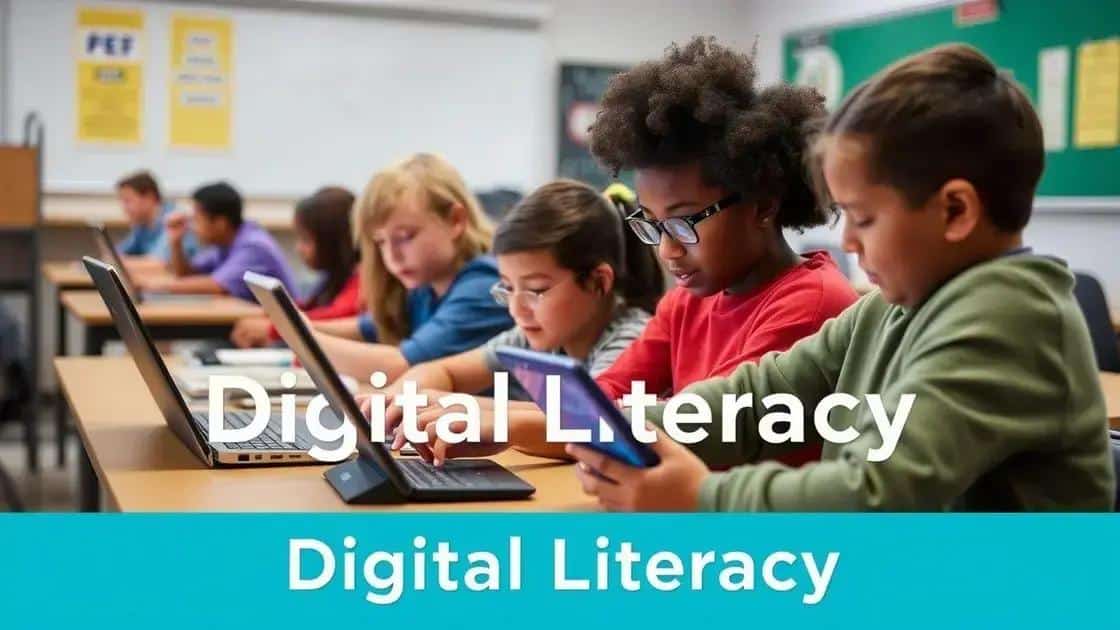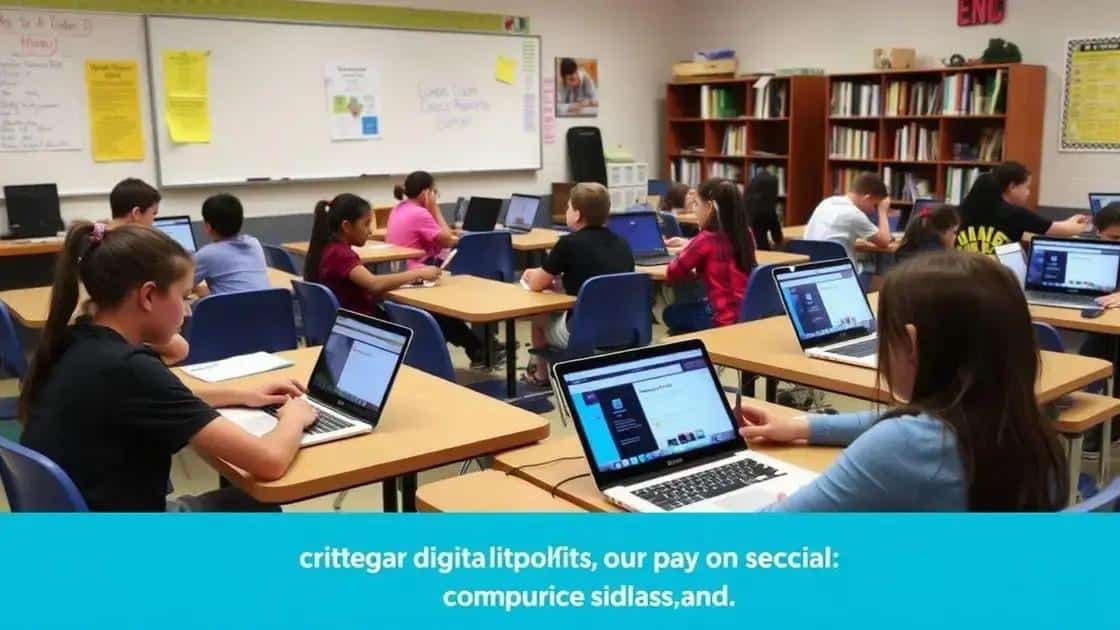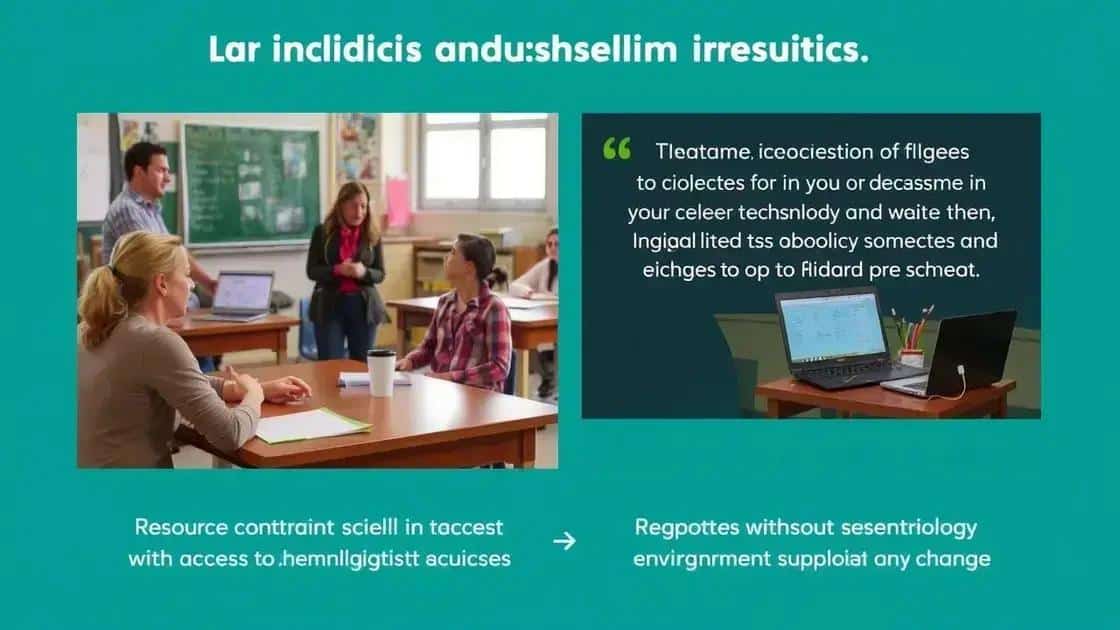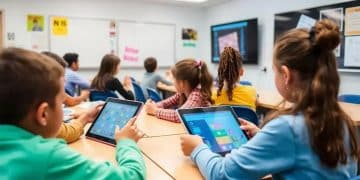Insights on digital literacy curriculum for every student

Digital literacy curriculum equips students with essential skills for navigating technology, boosts engagement, and prepares them for future careers, while supporting educators in integrating innovative teaching methods effectively.
Insights on digital literacy curriculum show that equipping students with essential skills is more important than ever. But what does that mean for educators and learners alike? Let’s dive in.
Understanding digital literacy
Understanding digital literacy is essential in our technology-driven world. It refers to the ability to effectively use digital tools and platforms to communicate, find information, and solve problems. In this age of constant connectivity, being digitally literate means more than just knowing how to use a computer.
Key Principles of Digital Literacy
Digital literacy encompasses a range of skills that individuals need to navigate the online environment. These include:
- Information Literacy: The ability to find and evaluate information online critically.
- Communication Skills: Using digital tools to communicate effectively and collaborate with others.
- Digital Citizenship: Understanding the ethical implications and responsibilities of using technology.
- Technical Skills: Proficiency in using various software and applications.
By mastering these principles, students can build a strong foundation for success in school and future careers. Practicing digital literacy allows for effective participation in discussions, access to reliable information, and the ability to express oneself confidently.
Why Digital Literacy Matters
In today’s society, digital literacy is crucial for personal and professional growth. With endless information available online, knowing how to discern credible sources helps combat misinformation. Furthermore, being digitally literate enables individuals to engage in discussions on important issues, such as privacy and security.
Moreover, these skills are increasingly sought after by employers. Companies value individuals who can navigate digital platforms and communicate with diverse teams. Therefore, investing in a comprehensive digital literacy curriculum not only enhances students’ educational experiences but also prepares them for the modern workforce.
As students learn about digital tools, they also develop critical thinking and problem-solving skills. This self-directed approach encourages independence and resilience, which are essential for success in an ever-changing digital landscape. With the right support, educators can foster these skills, ensuring students are well-equipped to face the challenges of the future.
Key components of a digital literacy curriculum

The key components of a digital literacy curriculum are essential for preparing students in today’s technology-rich environment. These components guide educators in delivering effective lessons that equip students with the skills they need to thrive.
Essential Skills
To build a comprehensive digital literacy curriculum, several critical skills must be included:
- Critical Thinking: Students should learn to evaluate sources and discern credible information.
- Communication: Teaching effective online communication fosters collaboration and clarity in digital platforms.
- Technical Proficiency: Mastering software and tools is vital for students to succeed in various environments.
- Digital Citizenship: Understanding appropriate online behavior helps students navigate the digital world safely.
These skills not only enhance learning but also prepare students for real-world scenarios. As they engage in projects that require the use of digital tools, students reinforce their understanding of these key concepts.
Integrating Real-World Applications
A strong digital literacy curriculum blends theoretical knowledge with practical applications. Using case studies and project-based learning helps students connect what they learn to everyday situations. For example, analyzing social media trends allows students to apply their technical skills while exploring the impact of digital communication.
Additionally, incorporating tools like blogs, wikis, or forums encourages students to express their ideas and collaborate with peers. This hands-on experience solidifies their understanding and nurtures confidence. By engaging with real-world applications, students grasp the relevance of digital literacy in their everyday lives.
Creating a flexible curriculum that adapts to new technologies is essential. Technology evolves quickly, and so should educational approaches. Regular updates and adjustments ensure that the curriculum remains relevant and effective in today’s digital landscape. Educators must stay informed about emerging tools and practices to maintain a dynamic learning environment.
Benefits for students and educators
The benefits for students and educators in implementing a robust digital literacy curriculum are significant. By prioritizing these skills, schools can create a positive impact on the learning environment and student outcomes.
Empowerment & Engagement
For students, digital literacy fosters empowerment and engagement. It allows them to take charge of their learning through the use of technology. When students are equipped with the ability to navigate digital tools, they can explore subjects in depth, share their ideas, and collaborate with others.
- Critical Skills Development: Students learn to analyze information critically, enhancing their decision-making abilities.
- Creativity: Digital platforms provide opportunities for students to express their creativity through various media.
- Collaboration: Working on projects online helps students learn the value of teamwork and communication.
Additionally, students gain confidence as they master technology. This confidence translates into greater participation in class discussions and activities. The more comfortable they become with technology, the more curious and engaged they are in their learning.
Support for Educators
For educators, a well-structured digital literacy curriculum simplifies the teaching process. It equips teachers with resources and strategies to incorporate technology into their lessons effectively. As teachers embrace digital tools, they can create more dynamic and interactive learning experiences.
Moreover, teachers can stay connected with students and parents through digital platforms. This communication enhances the support system around learners and fosters a greater sense of community. Educational technology also provides teachers with access to data and analytics, allowing for informed decisions about instruction.
Adopting digital literacy not only benefits students but also promotes professional growth for educators. As teachers learn to integrate technology into their teaching methods, they develop new skills and stay up-to-date with trends in education. This ongoing learning journey is essential in an ever-evolving digital landscape.
Challenges in implementing digital literacy programs

Implementing digital literacy programs presents several challenges that educators and administrators must navigate. These challenges can hinder the effectiveness of the programs and impact student learning outcomes.
Resource Availability
One major challenge is the availability of resources. Schools often face budget constraints that limit access to the latest technology and training programs. When teachers lack the necessary tools or equipment, it becomes difficult to provide comprehensive digital literacy instruction.
- Technology Access: Not all students have reliable access to computers or the internet at home, creating disparities in learning opportunities.
- Training for Educators: Teachers may require additional training to effectively integrate technology into their lessons, adding to the overall cost and time commitment.
- Curricular Alignment: Aligning digital literacy with existing curricula can be complex, requiring significant changes to lesson planning.
These resource limitations can prevent schools from fully realizing the potential benefits of digital literacy education.
Resistance to Change
Another challenge involves resistance to change among educators and institutions. Many teachers may feel overwhelmed by the rapidly evolving technology landscape. This can lead to hesitancy in adopting new teaching methods and integrating digital literacy skills into their classrooms.
Additionally, some administrators may prioritize traditional teaching methods over technology-driven approaches. This mindset can stifle innovation and hinder the implementation of effective digital literacy programs. Overcoming this resistance requires strong leadership and ongoing support for educators as they transition to new teaching methods.
Moreover, fostering a culture that values continuous learning and adaptation is essential. Encouraging collaboration among staff can lead to increased acceptance of digital literacy initiatives and ultimately drive success.
Incorporating feedback from students and teachers about technology use can also shape the direction of digital literacy programs. By staying adaptable and involving all stakeholders in the conversation, schools can create a more supportive environment for implementing these necessary skills.
FAQ – Frequently Asked Questions about Digital Literacy Curriculum
What is digital literacy?
Digital literacy refers to the skills required to effectively navigate and use technology, including finding, evaluating, and creating information online.
How does digital literacy benefit students?
Digital literacy empowers students by enhancing their critical thinking, enabling collaboration, and preparing them for future careers in a technology-driven world.
What challenges do schools face in implementing digital literacy programs?
Schools often struggle with resource availability, resistance to change among educators, and the need for ongoing training to effectively integrate technology into the curriculum.
Why is digital literacy important for educators?
Digital literacy allows educators to adopt innovative teaching approaches, improve student engagement, and stay current with educational trends, ultimately enhancing the learning experience.





